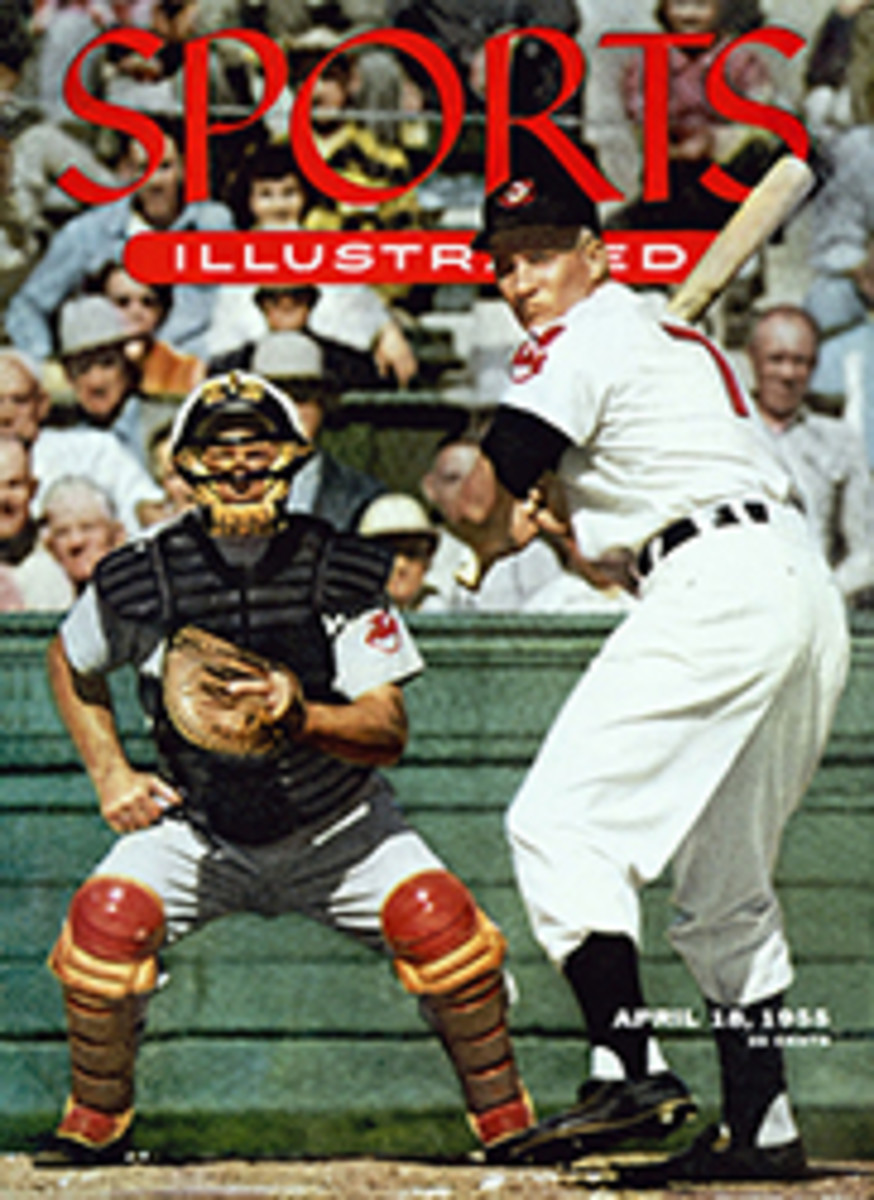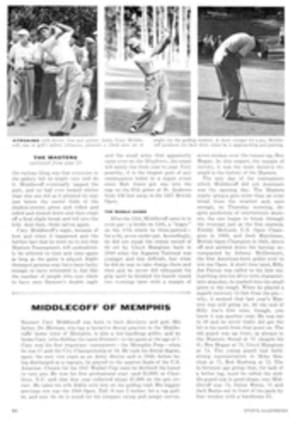
THEY ALL PUT KANSAS CITY LAST
Spring and the ballplayers were creeping north on reluctant feet, scenting the air with peach blossoms, arnica and sweat. Businessmen lunching together in New York argued baseball and challenged one another to handicap the pennant races, as thousands of others may have been doing at the same moment in a hundred other cities.
There were 10 at the table in New York. When they had drawn up their forecasts for the American League, five had the Yankees on top and the Indians second; five had Cleveland on top and New York second; all had the White Sox third; all placed Kansas City last.
These were amateur handicappers, which means they could be misguided, though probably not so grievously misinformed as the professionals whose opinions get published. Yet amateur or pro, their Delphic doodling called sharply to attention a fact which the American League prefers to ignore:
From third place down, there isn't any American League race. The league is out of joint like a contortionist's sacroiliac, unbalanced like the books of a horse-playing bank teller.
To put it with uncharitable candor, within less than two years two franchises have died and gone to Baltimore and Kansas City, whose resemblance to Heaven is superficial; as far as championship pretensions go, all but three are strictly from Saskatoon.
It is difficult to say how this came about in a league that used to go around busting its buttons with smug pride in its acknowledged superiority to the older National League. Maybe that smug pride is the answer; American Leaguers have been living in the past. They still think of their lodge in terms of Babe Ruth and Ty Cobb and Connie Mack, and while they preened themselves they were left behind.
Finding themselves in trouble, the owners have resorted to the oldest, seediest dodge known to the heads of poor ball clubs. They have taken to firing the manager.
As this season begins, only two of the eight teams are under the direction of the men who managed them last year. Casey Stengel, a bandy-legged godling, remains in New York where he has become a tourist attraction like the Radio City Music Hall or the Empire State Building. Al Lopez, whose Indians won the pennant last season, returns to Cleveland.
Paul Richards, whose White Sox finished third, quit Chicago to make better money as general manager and field manager in Baltimore. The five other managers got fired because their employers could think of no better way to make the fans believe they were trying.
Here's how the brains are distributed: Marty Marion's intellect now operates on behalf of the White Sox; Bucky Harris does the thinking for Detroit; Mike Higgins is apprentice genius in Boston; Charley Dressen's gray matter belongs to Washington; Lou Boudreau's skull encases most of the Kansas City talent.
All are gifted men, lacking nothing save ballplayers. Five of them figure to be lonely men this summer, pretty generally ignored while the fans watch New York, Cleveland and Chicago. What of these three? Well, take the Indians first, since they are defending champions.
Chances are there is no such title as "world's greatest baseball scout." If there were, nobody would have a stronger claim to it than slick, sly Cy Slapnicka of the Indians. He is a reformed pitcher who, according to the soundest authorities, knows all there is to know of the art of doctoring a baseball to make it do tricks which discourage and disconcert batsmen.
Years ago this adroit operator went out to Van Meter, Iowa, and there he found a farm boy who could do by accident all the things Slapnicka knew could be done to a baseball by design. This furrow-jumper's name is Bob Feller, maybe the greatest pitcher of our time and certainly one of the best in any era.
A couple of years ago Slapnicka came upon a cop in Lake Worth, Fla., who told him about a boy, transplanted from Long Island, who was pitching for the local high school. Ultimately Slapnicka gave this kid a $60,000 bonus to join the Cleveland organization. The kid is coming up this year and already the headlines are acclaiming him.
He is Herb Score, currently the most important single addition that has been made to the American League. He won 22 games for Indianapolis last year and set an American Association record with 330 strike-outs. In exhibition games this spring he awed the Giants with his fast ball.
Not once in a decade is a rookie pitcher the key man in a pennant race. Score doesn't have to be. Cleveland already had the most formidable pitching staff in the league. Add Score to a group that includes Bob Lemon, Early Wynn, Mike Garcia, Art Houtteman, Bob Feller, Don Mossi, Hal New-houser and Ray Narleski. There's no crew to compare with that.
The unreasonably articulate Dressen, who feels it incumbent on him to speak well of the Washington club because nobody else will, has brushed off Cleveland's prospects with the remark that "it all depends on how far Kiner has went back."
Fact is, Ralph Kiner is another addition to the Indians. Whatever ability this muscular character may have left, no matter how far he has went back, it is ability that Cleveland did not possess last year. This is the same team that won 111 games in 1954, plus Score, plus Kiner. In the World Series these slow-footed, brawny aborigines didn't look like the Indians who fought at Little Big Horn, but there isn't a real tough Custer in the whole American League.
CASEY STENGEL'S PRAYER
Defeated last season when old age caught up with their best players, the Yankees didn't go sit on a rock and cry. They went instead to Baltimore and got two pitchers, Bob Turley and Don Larsen, and a shortstop named Bill Hunter.
Turley is young and strong and fast and willing. Larsen is big and young and strong. Hunter is today what he was when the Browns brought him out of the minors two years ago, an infielder of unfulfilled promise. Even for the bale of players they got in exchange, the Orioles hated to give up Turley and Hunter. They were willing, to the point of eagerness, to give up Larsen.
When the New York training camp opened, Stengel didn't know who his regular shortstop would be, counted on Bob Grim and Whitey Ford as his first two pitchers, hoped Turley would be the Number Three man, counted on Ed Lopat as Number Five and prayed for guidance in the search for Number Four.
Starting the season now, he knows exactly what he knew then, and he's still praying.
New York won 103 games last year, enough for a pennant when somebody else doesn't win 111. The White Sox won 94, enough for a pennant if nobody wins 95. The Chicago situation is not unlike that of the Yankees: there's been a bit added here, a bit there, and it may or may not be enough.
If Walt Dropo can play first base, if George Kell is physically sound at third, if Chicago's pitchers are as good as they have been in the past, then the White Sox have a solid, balanced club, a bona fide contender.
That's the league.
In Boston they talk about Ted Williams—will he play or go fishing? The fans and newspapers don't know, the club doesn't know, and if Williams knows he isn't telling.
In Detroit and Washington and Baltimore they just talk. In Kansas City the rookie owner, Arnold Johnson, talks about the million he has on hand to spend for ballplayers. One of these days somebody will overhear him, and take the million.
[originallink:10460411:43460]
PHOTO
RITE OF SPRING SINCE 1910—THE PRESIDENT OF THE U.S. OPENS THE BASEBALL SEASON
ILLUSTRATION
ARNOLD PORTOCARRERO: Pitcher: KANSAS CITY ATHLETICS
ILLUSTRATION
AL ROSEN: 3rd base: CLEVELAND INDIANS
ILLUSTRATION
HAL SMITH: catcher: BALTIMORE ORIOLES
ILLUSTRATION
BOB KEEGAN: pitcher: CHICAGO WHITE SOX
ILLUSTRATION
FERRIS FAIN: 1st base: DETROIT TIGERS
ILLUSTRATION
FRANK SULLIVAN: pitcher: BOSTON RED SOX
ILLUSTRATION
BOB TURLEY: pitcher: NEW YORK YANKEES
ILLUSTRATION
ROY SIEVERS: outfield: WASHINGTON NATIONALS
EIGHT ILLUSTRATIONS
ILLUSTRATION
70
ILLUSTRATION
10
ILLUSTRATION
106
ILLUSTRATION
16
ILLUSTRATION
77
ILLUSTRATION
8
ILLUSTRATION
11
ILLUSTRATION
38
ILLUSTRATION
"Stay out of it. We have our own problems."
COLLECTORS' ITEMS
Baseball's opening day found the bubblegum season in full stride, small collectors scurrying everywhere in their determination to get every trading card available, including the choice selection of American Leaguers presented on the opposite page (courtesy Topps Chewing Gum, Inc.)

